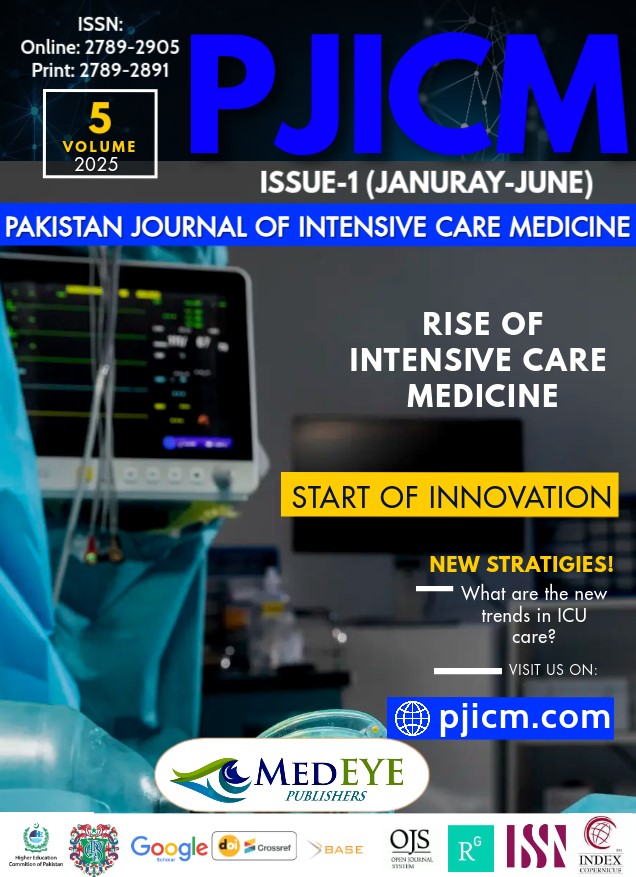FREQUENCY AND FACTORS OF HEMORRHAGIC TRANSFORMATION IN PATIENTS WITH ISCHEMIC STROKE
DOI:
https://doi.org/10.54112/pjicm.v5i01.48Keywords:
Hemorrhagic Transformation, Ischemic Stroke, Hypertension, Diabetes, Hyperlipidemia, Risk Factors, Intensive Care Unit, Parenchymal HematomaAbstract
Background: Hemorrhagic transformation (HT) is a serious complication of ischemic stroke that can significantly impact clinical outcomes. Identifying its frequency and associated risk factors is crucial for improving patient management and reducing morbidity and mortality. Understanding these risk factors may help in developing targeted preventive strategies and optimizing stroke treatment protocols. Objective: To determine the frequency of hemorrhagic transformation in ischemic stroke patients and to identify the associated risk factors contributing to its occurrence. Study Design: Descriptive study. Setting: The study was conducted in the Department of Neurology at Fauji Foundation Hospital in Rawalpindi. Duration of Study: This study was carried out from 11 July 2024 to 11 January 2025. Methods: A total of 180 ischemic stroke patients were enrolled in the study. Demographic data, medical history, and risk factors—including hypertension, diabetes, hyperlipidemia, ischemic heart disease, and smoking—were recorded. The frequency of HT was assessed using imaging modalities. Patient characteristics such as age, gender, and ICU admission were also analyzed. Statistical analyses, including chi-square and logistic regression, were performed to determine significant risk factors for HT, with a significance level set at p ≤ 0.05. Results: Among the 180 ischemic stroke patients, 17 (9.4%) developed HT. The most prevalent risk factors in the HT group were hypertension (70.6%), diabetes (58.8%), hyperlipidemia (41.2%), ischemic heart disease (23.5%), and smoking (41.2%). An age-related trend was observed, with the highest incidence of HT occurring in the 61–80 years age group (58.8%). Additionally, patients with HT had a higher ICU admission rate (35.3%) compared to those without HT (8.0%). Conclusion: This study highlights a significant association between hypertension, diabetes, hyperlipidemia, ischemic heart disease, and smoking with the development of hemorrhagic transformation in ischemic stroke patients. Early detection and management of these risk factors are essential in mitigating HT risk and improving patient outcomes. Close monitoring and individualized treatment strategies should be prioritized, particularly for high-risk patients, to reduce the likelihood of severe HT complications.
References
Campbell BC, De Silva DA, Macleod MR, Coutts SB, Schwamm LH, Davis SM, Donnan GA. Ischaemic stroke. Nat Rev Dis. 2019;5(1):70
Johnson CO, Nguyen M, Roth GA, Nichols E, Alam T, Abate D, et al. Global, regional, and national burden of stroke, 1990–2016: a systematic analysis for the Global Burden of Disease Study 2016. Lancet Neurol. 2019;18(5):439-58.
Hong JM, Kim DS, Kim M. Hemorrhagic transformation after ischemic stroke: mechanisms and management. Front Neurol. 2021;12:703258.
Spronk E, Sykes G, Falcione S, Munsterman D, Joy T, Kamtchum-Tatuene J, Jickling GC. Hemorrhagic transformation in ischemic stroke and the role of inflammation. Front Neurol. 2021;12:661955.
Honig A, Percy J, Sepehry AA, Gomez AG, Field TS, Benavente OR. Hemorrhagic transformation in acute ischemic stroke: a quantitative systematic review. J Clin Med. 2022;11(5):1162.
Jaillard A, Cornu C, Durieux A, Moulin T, Boutitie F, Lees KR, et al. Hemorrhagic transformation in acute ischemic stroke: the MAST-E study. Stroke. 1999;30(7):1326-32.
Hassan AE, Kotta H, Shariff U, Preston L, Tekle W, Qureshi A. There is no association between the number of stent retriever passes and the incidence of hemorrhagic transformation for patients undergoing mechanical thrombectomy. Front Neurol. 2019;10:818.
Zhang X, Xie Y, Wang H, Yang D, Jiang T, Yuan K, et al. Symptomatic intracranial hemorrhage after mechanical thrombectomy in Chinese ischemic stroke patients: the ASIAN score. Stroke. 2020;51(9):2690-6.
Yu X, Pan J, Zhao X, Hou Q, Liu B. Predicting hemorrhagic transformation after thrombectomy in acute ischemic stroke: a multimodal score of the regional pial collateral. Neuroradiology. 2022;64(3):493-502.
National Institute of Neurological Disorders and Stroke rt-PA Stroke Study Group. Tissue plasminogen activator for acute ischemic stroke. N Engl J Med. 1995;333(24):1581-8.
Del Zoppo GJ, Saver JL, Jauch EC, Adams Jr HP. Expansion of the time window for treatment of acute ischemic stroke with intravenous tissue plasminogen activator: a science advisory from the American Heart Association/American Stroke Association. Stroke. 2009;40(8):2945-8.
Jauch EC, Saver JL, Adams Jr HP, Bruno A, Connors JJ, Demaerschalk BM, et al. Guidelines for the early management of patients with acute ischemic stroke: a guideline for healthcare professionals from the American Heart Association/American Stroke Association. Stroke. 2013;44(3):870-947.
Berkhemer OA, Fransen PS, Beumer D, Van Den Berg LA, Lingsma HF, Yoo AJ, et al. A randomized trial of intraarterial treatment for acute ischemic stroke. N Engl J Med. 2015;372(1):11-20.
Turc G, Bhogal P, Fischer U, Khatri P, Lobotesis K, Mazighi M, et al. European Stroke Organisation (ESO)-European Society for Minimally Invasive Neurological Therapy (ESMINT) Guidelines on Mechanical Thrombectomy in Acute Ischemic Stroke. Neurintsurg-2018-014569. 2019
Aljundi ZE, Miyajan EO, Alharbi HA, Sindi RH, Aldhahwani RM, Bajaber ZN, et al. Incidence, risk factors, clinical presentation, and outcomes of hemorrhagic transformation in patients with ischemic stroke admitted to a tertiary hospital in Kingdom of Saudi Arabia. Neurosciences. 2020;25(5):345-9.
Larrue V, von Kummer R, Müller A, Bluhmki E. Risk Factors for Severe Hemorrhagic Transformation in Ischemic Stroke Patients Treated With Recombinant Tissue Plasminogen Activator. Stroke. 2001;32(2):438-441.
Levent ÖC, Güner D, Uludağ İF, Tiftikçioğlu Bİ, Zorlu Y. Risk factors for hemorrhagic transformation in patients with acute middle cerebral artery infarction. Nöro Psikiyatri Arşivi. 2015 Dec;52(4):342.
Lindley RI, Wardlaw JM, Sandercock PA, Rimdusid P, Lewis SC, Signorini DF, et al. Frequency and Risk Factors for Spontaneous Hemorrhagic Transformation of Cerebral Infarction. J Stroke Cerebrovasc Dis. 2004;13(6):235-246.
Downloads
Published
How to Cite
Issue
Section
License
Copyright (c) 2025 Z AHMAD , H HASHIM , L AFREEN , M KHAN

This work is licensed under a Creative Commons Attribution-NonCommercial 4.0 International License.












